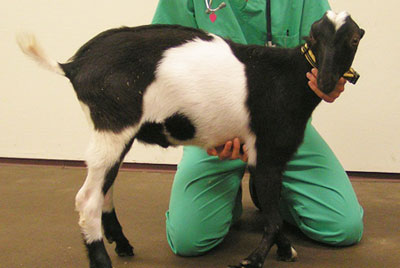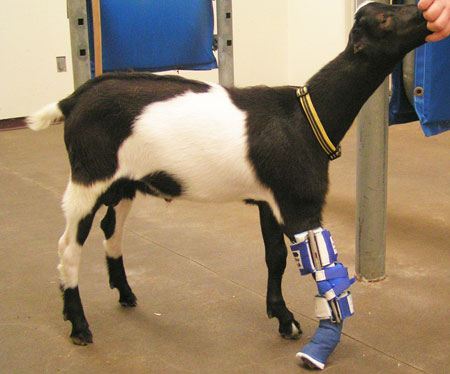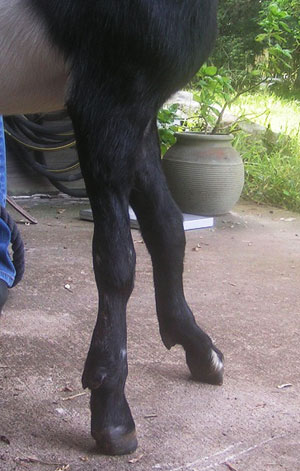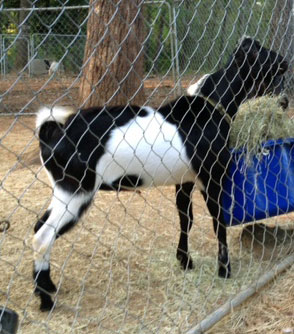A Difficult Birth

Kidding is difficult. Even in situations where every precaution is taken, problems can still occur. In the case of Challenger, the LaMancha kid, his position in the womb prevented him from coming out normally. As he was assisted out, his right forelimb was traumatized.
He was brought to his caretaker, Elise Anderson, an experienced goat breeder and part-owner of Rachelsie Dairy Goats, who had the tools and patience for this type of problem.
“We used cold towels and liniment to reduce the swelling, but I soon realized that it was more than just a little problem,” Anderson said. “I took the kid to my vet, Dr. Jeff Laraway from Shelton Veterinary Clinic, for evaluation and radiographs. That is when he was diagnosed with a broken elbow.”
To be exact, Challenger suffered from a Salter Harris Type II fracture of the distal humerus. This not an uncommon fracture but it is very difficult to treat. In a kid that is growing quickly, stabilizing it so that it could heal properly would be a challenge. It was at this time that Elise chose the name “Challenger.”
“The most common solution for a 4-day-old newborn buckling with a broken elbow is to have the kid euthanized,” Anderson said, “but this kid had such a sweet nature and never complained, so I wanted to do more. Since I am a ‘regular’ at the UF Large Animal Hospital, I offered to take him there to see if there was anything that the UF vets could do.”
UF Care
At UF, Challenger was admitted to the UF Large Animal Surgery Service, where Dr. Sarah Graham, Large Animal Surgery Clinical Assistant Professor, along with Dr. Andrew Smith, Large Animal Surgery Resident, examined the kid and the radiographs from Dr. Laraway.
The veterinarians at UF work together with animal owners to provide the best care possible for pets while staying within each client’s budget. Especially with some farm animals, it can be difficult to save every animal when considering the economic realities of running a farm.
“Based on Challenger’s injury, there were a few different options for care that ranged from conservative management to surgery,” Dr. Smith said.
Elise chose the more conservative route and a spica splint was applied to the right forelimb. He was young and a well-behaved kid, so it was a suitable option for him.
The veterinarians at UF applied the bandage and prescribed pain medications for Challenger. He was kept at the hospital for a few days for monitoring and care. After three days, Challenger was sent home with instructions to keep him as still and as comfortable as possible.
A Small Set Back
A few weeks into the healing process, a recheck examination at the UF Large Animal Hospital showed that the fracture was healing well and the bandages were removed. He went home and was improving for a little while, but at his next recheck things weren’t looking so positive. Unfortunately, Challenger now had a new problem. Once the bandages were removed, he started spending a lot of time with the leg bent, which lead to contraction of the carpus (knee joint). This contracture was starting to severely limit his range of motion and use of that leg.
What Challenger needed was to have the tendons in the forelimb stretched to allow the carpal joint full range of motion so that the limb could be used correctly. This process can be difficult but not impossible.

Dr. Smith recommended a special splint called the DynasplintTM. The DynasplintTM is a splint that can apply a gentle, adjustable pressure across the joint to counteract the shortened tendon. This force gradually lengthens the tendon and soft tissue structures of the joint, increasing the range of motion while supporting the joint in its correct position. DynasplintsTM are used in a variety of animal species, but were originally developed for human patients. Dr. Martha Mallicote, UF Large Animal Medicine Clinician, was also involved in Challenger’s case, helping monitor the healing process.
“The DynasplintTM was the perfect tool to help the joint get back to normal function,” Dr. Mallicote said. “We couldn’t risk him having any more problems without the possibility of permanent damage.”
The DynasplintTM was applied at the hospital with the help of DynasplintTM representatives. The splint was aligned with the radius and cannon bone, putting constant, mild tension on the carpus. Velcro closures were adjusted to keep the splint tight and in place. Anderson was instructed to have Challenger wear the splint for two hours on the first day, then increase daily by two hour increments until he was wearing the splint eight hours per day.
Good to Go!
“We had to monitor Challenger in shifts because he could not be left unattended while in the splint,” Anderson said. “He learned how to undo the Velcro, so we had to add an extra layer of wrap but he was a good sport.”
Fortunately for Challenger and Anderson, the DynasplintTM worked perfectly. The tendon was stretched continuously yet gently and eventually the leg was healed enough to have the splint removed.
“The whole process was absolutely worth it,” Anderson said. “It’s made him a big ham – he loves attention. Physically and mentally, this has not caused him one bit of problems.”
Soon after getting a clean bill of health, Challenger went to his new home in South Carolina as a herd sire. Anderson and the veterinarians at UF are happy with the final result.
“This was a difficult case because Challenger was growing very fast. Even in young animals, fractures can take a long time to heal and there can be complications,” Dr. Smith said. “I am glad Elise was willing to work with Challenger.”
To Anderson, it was Challenger’s sweet demeanor that started the entire process.
“I couldn’t be happier with the outcome of Challenger and I am glad that I was able to give him every option that I could,” Anderson said. “One look at him now as a typical goat – running, playing and able to breed does – and I see what this was all about. He is living a happy life now, which is all I wanted.”
View all UF Large Animal Hospital Success Stories







